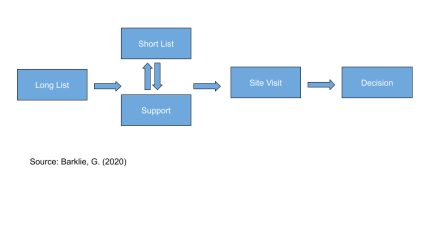

An investor has decided to take his or her existing operation to a new country, but how do they decide which location is the right one? Although the processes may vary depending on the size of the company and the type of operation being created, there are generally five key components – the long list, the short list, support from intermediaries, site visits and, finally, the decision.
 Matthijs Weeink, director of business location consulting at Jones Lang LaSalle, believes that “the first three stages of the process are data driven and analytical”. Stage four, the site visit, “allows you to validate or adjust the data used in your model as well as carry out a qualitative assessment of things that cannot be captured in a database”, he adds.
Matthijs Weeink, director of business location consulting at Jones Lang LaSalle, believes that “the first three stages of the process are data driven and analytical”. Stage four, the site visit, “allows you to validate or adjust the data used in your model as well as carry out a qualitative assessment of things that cannot be captured in a database”, he adds.
However, “the decision-making processes vary significantly depending on company size, the sector and activity involved”, according to Martin G Kaspar, head of corporate development at a German automotive supplier. He adds that “time invested in the search process tends to de-risk the project”.
How to make a long list
Typically, a decision maker will have some initial thoughts on potential locations. These may be locations in which he or she has previously worked, or locations that they have visited. The company may also be aware of locations in which its peers have operations that may warrant consideration. Additionally, a quick internet search can often provide an array of rankings and indexes of locations – albeit probably on a more generalised scale. However, these can still provide some insight. Consultants and subscription databases and tools can also provide a more tailored assessment; however, these will come with an attached cost.
A long list should generally consist of no more than ten locations.
Narrowing the long list to a short list
Once a long list has been created, these locations must be qualified – do they suit the investor’s criteria? A prerequisite of this is that the investor knows the key drivers for his or her investment. For example, if the investor is planning to create a 1,000-person manufacturing operation, there may be more cost sensitivities. If the investor is looking to develop a new drug, high-quality talent may be a key driver. Most companies have a range of factors that they consider. These include the business environment, competition, cost, infrastructure, labour quality and availability, living environment, networks and market demand, among others.
How well do you really know your competitors?
Access the most comprehensive Company Profiles on the market, powered by GlobalData. Save hours of research. Gain competitive edge.

Thank you!
Your download email will arrive shortly
Not ready to buy yet? Download a free sample
We are confident about the unique quality of our Company Profiles. However, we want you to make the most beneficial decision for your business, so we offer a free sample that you can download by submitting the below form
By GlobalDataWeeink suggests “finding a good balance between three aspects: the cost, risk and ease of doing business”. Mark Wakem, project director, global markets at Aburi Composites, notes that partners and supply chains are of key importance for his company. Kaspar, meanwhile, highlights that “money and land are often not the limiting factors; most of the time it is finding qualified people”.
Benchmarking the long list of locations against a range of criteria should help remove those locations that are less suited to an investor’s needs. It is unlikely that there will be a single location that will tick every box. A cost-benefit analysis should at least provide an ordering of locations.
A short list should be no more than five locations.
Where to look to for support?
Many companies, particularly smaller companies without the resources or teams in place to conduct a large-scale site-selection process, will often seek out support. This can come from an array of intermediaries: business services professionals, consultants, investment promotion agencies (IPAs), property specialists, site-selection experts, utility providers and many more.
An IPA is generally a good place to start. In most cases, agency advice and support will be free. IPAs can provide information on a location that may be difficult to attain prior to a site visit.
Edith Wong, chief marketing officer at Invest Hong Kong, says the role of an IPA is to “provide clients with the relevant information and support to facilitate their decision-making process”. Although services can differ between agencies, a typical agency will be able to provide statistics and information and act as a directory to other key contacts. Invest Hong Kong “also offers a range of facilitation services, from visa applications, opening bank account, to finding spaces in international schools for expatriate children and identifying ways of finding the right staff through universities and recruitment agencies”, Wong adds.
Companies contact agencies at different stages throughout their decision process for support. Weeink says: “In most instances, clients will engage at the long list stage when the business case is still quite fluid.” However, he notes there are instances where a client will look for support further down the chain.
Sherry Ambrose, manager of economic development at Florida Power and Light (FPL), echoes this opinion. She says that companies approach FPL at all stages in the decision-making process, but stresses that using resources at an earlier stage can yield more benefits as there is “less that agencies can do when approached at a later stage when a deal has been signed”. She advises companies “to take advantage of support and services provided by economic development organisations”.
However, an IPA may not always be required. Wakem notes that due to the niche market in which Aburi Composites operates, it does not necessarily look to third parties to help in the decision-making process.
Why it is necessary to do site visits
Although gathering as much information as possible to inform any decision is good practice, Kaspar states that in order to make investment decisions, an investor “has to be on the ground”. He notes that agencies may provide valuable data for desk research, but it is nonetheless important to spend time in the country to complete the picture of potential locations.
A site visit naturally entails going to the location. It is important to organise a schedule to get the most out of a visit. An investor may want to visit on a ‘standard day’ – i.e. non-public holiday – to see how the location typically operates. Ensure all meetings have been pre-booked and there is plenty of time to navigate from one meeting to the next. An investor should ensure a logical tour of the area(s) that are being viewed, minimising being in transit. Office/plant buildings or site areas should be viewed to get a feel for the infrastructure and answer questions such as: can a workforce easily reach the site? The investors should speak with local business leaders to get a sense of the business environment, and contact recruitment companies to help find local talent. In some cases, connecting with a university may well be a good idea, as will getting a sense of the living environment the location offers, which can be important factor in attracting talent. An IPA can typically help organise a visit that takes in all of these factors.
Weeink advises clients to “have a backup location in case a site visit highlights any issues such as pollution, or [unsuitable] neighbours”.
An investor should be looking to visit at least one location, but ideally two or three.
Should Covid-19 affect the decision-making process?
The Covid-19 pandemic has had a negative impact on foreign direct investment (FDI) and site selection. According to the UN Conference on Trade and Development, FDI is predicted to fall by up to 40% in 2020. With regards to site selection, Wakem says: “Covid has made a challenging project even more challenging.”
Company representatives in most sectors are unable to be on the ground to validate sites. Wakem adds that it has become “impossible to connect with third parties” in certain areas. He highlights that middle and lower-income markets have been harder hit as amenities available in an office, such as IT infrastructure, may not be available at home.
Many IPAs are seeing enquiries decline by at least one-third. Wong says: “In light of the Covid-19 pandemic and global economic uncertainty, it is more important than ever for companies to engage local partners in the relocation or expansion process.”
There may also be a change in the places where companies have historically established a presence. Weeink says: “There may be movement away from traditional central business districts to more regional areas and out-of-town business parks.”
Kaspar adds that long and complex supply chains are increasingly being broken up to de-risk supplies. He concludes: “We may therefore witness less trade across borders, and more investment in core markets, closer to the final customers.”
Companies embarking on a new FDI adventure should be mindful of the existing landscape – keeping abreast of any government guidelines – but also be forward-looking. The world will return to (a new) normal at some point, and FDI will be a part of it. Investors must be well-prepared, analyse potential locations, engage with intermediaries, if necessary, to answer any questions, have a well-defined itinerary for site visits, and ensure the proposed location fits as many requirements as possible.




